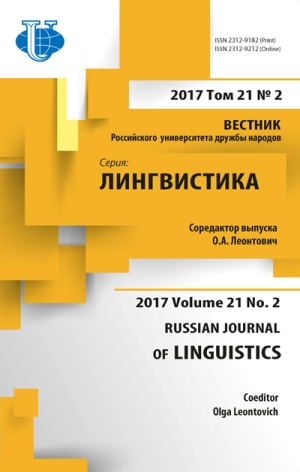Narratives about Displacement and Stigmatization of Identities
- Authors: de Oliveira M.C.1, Lisboa C.M.1
-
Affiliations:
- Pontifical Catholic University of Rio de Janeiro
- Issue: Vol 21, No 2 (2017)
- Pages: 320-334
- Section: Articles
- URL: https://journals.rudn.ru/linguistics/article/view/15900
- DOI: https://doi.org/10.22363/2312-9182-2017-21-2-320-334
Cite item
Full Text
Abstract
The displacement of people who leave their home to live in the streets is one of the social dramas commonly found in large urban areas. Despite forming a heterogeneous population group, these people are seen by society as one homogenous crowd, grouped together based on the generalizations of negative categorizations attributed to them. This article analyzes the displacement storytelling of a woman who lost her house to heavy rainstorms, which forced her to go live in the streets with her seven youngest children. Based on the concepts of membership categorization analysis, stigma and talking back, we aim to investigate how this former street dweller refutes the stigmatized identities that she knows are attributed to her, as well as how she claims an alternative identity. Her narrative was produced in the context of an interview for research on life stories. The results show that the storyteller seeks to build a coherent narrative for her own self by adopting a belief system to organize her life story and by providing explanations to the events in her life. Accordingly, she blames the street dwellers’ deviant behavior on the street environment, and also claims her status as a member of the “family” collection by invoking the dominant discourse on motherhood as an ideal of female fulfillment. Ultimately, this study highlights the importance of knowing the native categories, that is, the categories created by the members of the group whose actions are being studied, which challenge the categories conceived by outsiders.
About the authors
Maria Carmo de Oliveira
Pontifical Catholic University of Rio de Janeiro
Author for correspondence.
Email: mcleitedeoliveira@gmail.com
225 Rua Marquês de São Vicente, 22453-900 Gávea, Rio de Janeiro, Brazil
Carla Matos Lisboa
Pontifical Catholic University of Rio de Janeiro
Email: mirellematos@gmail.com
225 Rua Marquês de São Vicente, 22453-900 Gávea, Rio de Janeiro, Brazil
References
- Badinter, E. (1980) L'amour en plus: Histoire de l'amour maternel (XVIIe-XXe siècle). Paris, France: Flammarion
- Brêtas, P. (2016, May 11) Aluguel social: governo do Rio corta benefício de 9 mil famílias removidas de áreas de risco. Jornal Extra. Available at: http://extra.globo.com/noticias/economia/ aluguel-social-governo-do-rio-corta-beneficio-de-9-mil-familias-removidas-de-areas-de-risco-20416214.html-ixzz4PAIvu8zr
- Denzin, N. K., & Lincoln, Y. S. (2003) The Landscape of Qualitative Research: Theories and Issues. Thousand Oaks, CA: SAGE Publications
- Garcez, P. M. (2002) Transcrição como teoria: a identificação dos falantes como atividade analítica plena. In L. P. Moita lopes & L. C. Bastos (eds.). Identidades: recortes multi e interdisciplinares. Campinas, SP: Mercado das Letras
- Garcez, P. M. (2008) A perspectiva da Análise da Conversa Etnometodológica sobre o uso da linguagem em interação social. In L. L. Loder & N. M. Jung (eds.), Fala-em-interação social: introdução analise da conversa etnometodológica. Campinas, SP: Mercado de Letras, 17-38
- Garfinkel, H. (1967) Studies in ethnomethodology. Englewood Cliffs: Prentice-Hall
- Goffman, E. (1963) Stigma: notes on the management of spoiled identity. Englewood Cliffs: Prentice-Hall
- Governo do Rio de Janeiro, & Secretaria de Estado de Assistência Social e Direitos Humanos. (2016, May 11) Assistência Social e Direitos Humanos - Aluguel Social. Available at: http://www.rj.gov.br/web/seasdh/exibeconteudo?article-id=1519686
- Hall, S. (1992) The Question of Cultural Identity. In T. McGrew, S. Hall, & D. Held (Cambridge: Polity Press. eds.), Modernity and its Futures: Understanding Modern Societies, Book IV, 273-316
- Jefferson, G. (1974) Error Correction as an Interactional Resource. Language in Society, 3(2), 181-199
- Juhila, K. (2004) Talking Back to Stigmatized Identities: Negotiation of Culturally Dominant Categorizations in Interviews with Shelter Residents. Qualitative Social Work, 3(3), 259-275
- Mandelbaum, J. (2013) Storytelling in conversation. In J. Sidnell & T. Stivers (eds.), The handbook of conversation analysis (pp. 492-508). Oxford: Wiley-Blackwell
- Mishler, E. G. (1986) Research interviewing: context and narrative. Cambridge, Mass: Harvard University Press
- Morgan, S. (2000) ‘Three Prisoners’ Stories: Talking Back Through Autobiography’. In J. Batsleer & B. Humphries (eds.) Welfare, Exclusion & Political Agency. London: Routledge,190-212
- Sacks, H. (1995) Lectures on Conversation, Volumes I and II Oxford: Wiley-Blackwell
- Scavone, L. (2001) A maternidade e o feminismo: diálogo com as ciências sociais. Cadernos Pagu, 16, 137-150
- Schegloff, E. A. (1997) “Narrative Analysis” Thirty Years Later. Journal of Narrative and Life History, 7(1-4), 97-106. doi: doi: 10.1075/jnlh.7.11nar
- Schneider, B., & Remillard, C. (2013) Caring about homelessness: how identity work maintains the stigma of homelessness. Text & Talk, 33, 95-112
- Scott, M. B., & Lyman, S. M. (1968) Accounts. American Sociological Review, 33(1), 46-62. doi: 10.2307/2092239
- Sell, M., & Ostermann, A. C. (2009) Análise de categorias de pertença (ACP) em estudos de linguagem e gênero: a (des)construção discursiva do homogêneo masculino. Alfa: Revista de Linguística, 53(1), 11-34
- Sidnell, J. (2010) Conversation Analysis: An Introduction. Oxford: Wiley Blackwell
- Silverman, D. (1998) Harvey Sacks: Social Science and Conversation Analysis. New York, NY: Oxford University Press
- Trubilhano, A. G. (2011) Rua dos bobos, número zero: As estratégias de sobrevivência de pessoas em situação de rua. Universidade Presbiteriana Mackenzie, São Paulo, Brazil [Thesis]. Available at: http://www.mackenzie.br/fileadmin/Graduacao/CCBS/Cursos/Psicologia/2012/BIBLIOT_DIG_ LEVV/JUSTICA_E_CID/Amanda_Gongora_Trubilhano.pdf
- Vieira, M. A. d. C., Bezerra, E. M. R., & Rosa, C. M. M. (1994) População de rua: quem é? Como vive? Como é vista? São Paulo, SP: Hucitec

















